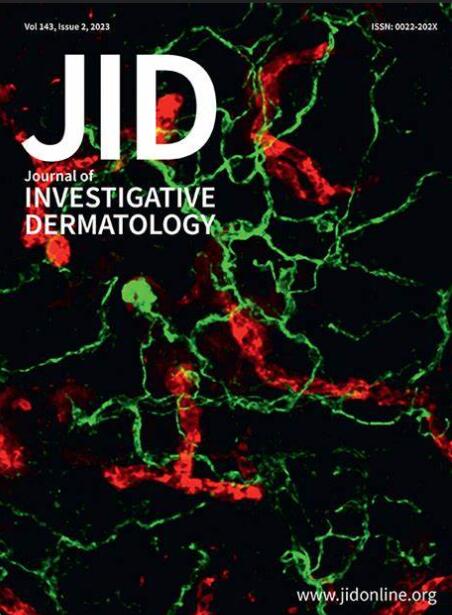Neurturin GF Enhances the Acute Cytokine Response of Inflamed Skin
IF 5.7
2区 医学
Q1 DERMATOLOGY
引用次数: 0
Abstract
Epidermal keratinocytes, immune cells, and sensory nerves all contribute to immune balance and skin homeostasis. Keratinocyte’s release of GFs, neuromodulators, and immune activators is particularly important because each can evoke local (skin) and systemic (ie, immune and neural) responses that can initiate and exacerbate skin pathophysiology. From studies of skin and neural GFs, we hypothesized that neurturin (Nrtn), a member of the GDNF family that is expressed in the skin, has particular importance in this process. In this study, we examine how elevation of Nrtn in skin keratinocytes impacts early cytokine expression in response to complete Freund’s adjuvant–mediated inflammation. Nrtn-overexpressing mice and wild-type mice injected with Nrtn exhibit an enhanced level of TNFα and IL-1β cytokines in the skin, a response previously shown to support healing. In vitro assays suggest that one source of the Nrtn-induced TNFα increase is keratinocytes, which are shown to express Nrtn and mRNAs encoding the Nrtn receptors GFRα2, Ret, ITGB1, and NCAM. These findings support the contribution of keratinocyte-derived Nrtn as an autocrine/paracrine factor that acts as a first-line defense molecule that regulates the initial cytokine response to inflammatory challenge.
Neurturin 生长因子可增强发炎皮肤的急性细胞因子反应。
表皮角质细胞、免疫细胞和感觉神经都对免疫平衡和皮肤平衡做出了贡献。角质细胞释放的生长因子、神经调节剂和免疫激活剂尤为重要,因为每种物质都能诱发局部(皮肤)和全身(即免疫和神经)反应,从而引发和加剧皮肤病理生理学。通过对皮肤和神经生长因子的研究,我们推测在皮肤中表达的神经胶质细胞系衍生神经营养因子(GDNF)家族成员神经营养素(Nrtn)在这一过程中具有特别重要的作用。在这里,我们研究了皮肤角质形成细胞中 Nrtn 的升高如何影响早期细胞因子的表达,以应对完全弗氏佐剂(CFA)介导的炎症。在角朊细胞中过表达 Nrtn 的小鼠(NrtnOE 小鼠)和注射了 Nrtn 的 WT 小鼠的皮肤中 TNFα 和 IL-1β 细胞因子的水平都有所提高,而这种反应以前曾被证明是支持愈合的。体外试验表明,Nrtn 诱导的 TNFα 增加的一个来源是角质形成细胞,这些细胞表达 Nrtn 和编码 Nrtn 受体 GFRα2、Ret、Itgβ1 和 NCAM 的 mRNA。这些研究结果表明,角质形成细胞衍生的 Nrtn 是一种自分泌/旁分泌因子,可作为一线防御分子,调节对炎症挑战的初始细胞因子反应。
本文章由计算机程序翻译,如有差异,请以英文原文为准。
求助全文
约1分钟内获得全文
求助全文
来源期刊
CiteScore
8.70
自引率
4.60%
发文量
1610
审稿时长
2 months
期刊介绍:
Journal of Investigative Dermatology (JID) publishes reports describing original research on all aspects of cutaneous biology and skin disease. Topics include biochemistry, biophysics, carcinogenesis, cell regulation, clinical research, development, embryology, epidemiology and other population-based research, extracellular matrix, genetics, immunology, melanocyte biology, microbiology, molecular and cell biology, pathology, percutaneous absorption, pharmacology, photobiology, physiology, skin structure, and wound healing

 求助内容:
求助内容: 应助结果提醒方式:
应助结果提醒方式:


